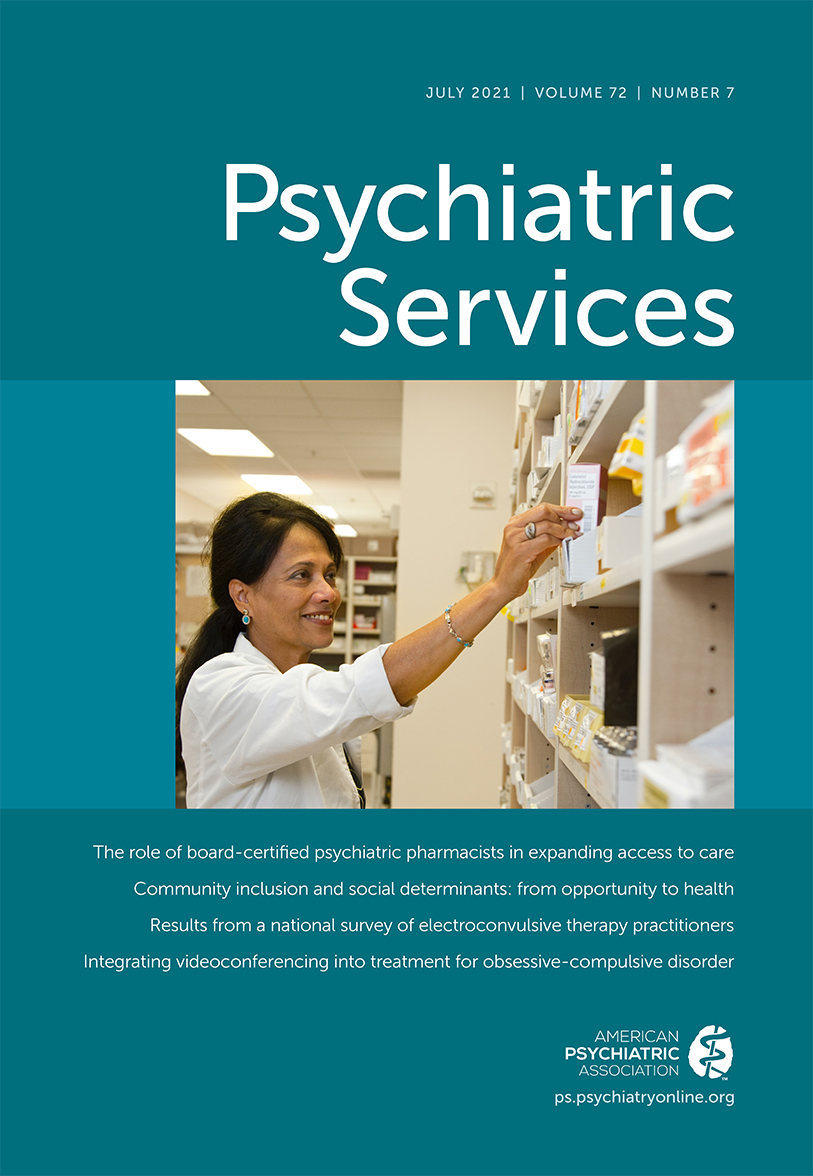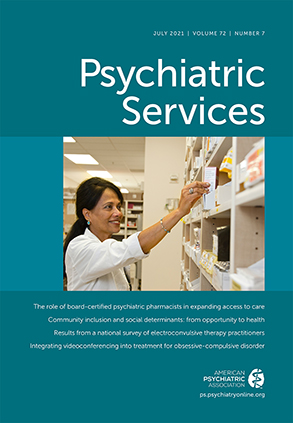Electroconvulsive therapy (ECT) is an effective treatment for major depressive disorder and other psychiatric disorders. When treating major depressive disorder, first-line ECT can produce remission rates of 80%–90%. In regard to treatment-resistant depression, ECT remission rates are 50%–70% in clinical trials (
1). This finding compares favorably with oral antidepressant remission rates of 13%–14% for treatment-resistant depression from the Sequenced Treatment Alternatives to Relieve Depression trial (
2). In addition to efficacy for major depressive disorder, recent trials have confirmed that ECT is efficacious among individuals with schizophrenia that is resistant to clozapine (
3) and among individuals with bipolar depression that is treatment resistant (
4). With respect to population health, ECT has been shown to lead to lower rates of rehospitalization (
5) and to mitigate suicidal ideation (
6); in addition, ECT may be cost effective after just one or two failed oral antidepressants (
7).
Although major depressive disorder is not the only indication for ECT, it is the most common one (
8). However, growing evidence suggests that a small portion of patients with depression actually receive ECT. Using the MarketScan data set of privately insured individuals (representing 47 million Americans), researchers showed that approximately 0.25% of individuals with major depressive disorder received one or more ECT treatments in 2015 (
9). Even among patients older than age 65, for whom ECT is particularly helpful (
10), another recent analysis that used Medicare data showed that ECT was provided for only 0.41% of patients with major depressive disorder (
11). The rate of ECT use has decreased substantially, especially among older patients, since the mid-1990s (
12).
Expert opinion suggests that several factors might be limiting the implementation of ECT, including stigma, bureaucratic rules on reimbursement, high cost, and lack of adequately trained staff (
13). However, no systematic investigation has been conducted regarding the relative contribution of different barriers to implementation. We sought to quantitatively examine the barriers to ECT implementation from the perspective of the provider via a nationwide survey. We also examined regional variation in ECT availability on the basis of the Medicare Provider Utilization and Payment Database.
Discussion
To our knowledge, this study is the first attempt to quantitatively compare provider-perceived barriers with ECT service expansion or initiation and the first nationwide survey of ECT providers. Qualitative data showed at least 22 barriers to initiating or expanding an ECT service. With respect to expanding an existing service, the most prominent provider-reported barriers were lack of physical space, stigma on the part of patients, and transportation issues. With respect to initiating a new service, the most prominent provider-reported barriers were lack of well-trained colleagues and ECT practitioners, lack of a champion, and lack of physical space. We also found great geographical variation in the availability of ECT providers.
Lack of physical space was identified as a prominent barrier for both initiating new ECT services and expanding existing ones. From qualitative interviews, this barrier seemed tied to low reimbursement rates of ECT relative to other procedure-based diagnostics and therapies (i.e., colonoscopies). The narrative that emerged from these interviews was that, from an administrative perspective, ECT is often the lowest on the “procedural totem pole.” If another higher-revenue clinical service needs additional space, ECT services might be displaced.
Expectedly, our data show that having a dedicated space in which ECT was performed was significantly related to the size of the ECT service (Table
1). If ECT is performed in space borrowed from a surgical recovery area (i.e., a PACU), all ECT patients must be ready for discharge by the time that the first wave of surgeries starts to finish (approximately 10 a.m.). In contrast, services with dedicated space can schedule patients into the afternoon, accommodating a greater volume of patients per day and increasing revenue. Therefore, advocating for dedicated ECT space requires forward-thinking financial projections that include potential cost savings by, for example, offsetting rates of readmission and duration of inpatient hospital stay if outpatient services can be accommodated. It should be noted, however, that this relationship could be bidirectional; hospital administrators may not be willing to invest capital in smaller ECT services.
Two potential remedies for this barrier include enhancing the reimbursement rate for ECT (which can be done on a local basis with private insurers), to enhance the value of ECT in the eyes of administrators, and adjusting Centers for Medicare and Medicaid Services rules that do not allow for reimbursement of ECT in ambulatory surgical centers (current regulations mandate that ECT be performed in a hospital). The latter policy change would create more of a “buyer’s market” for ECT practitioners and might be cost saving from the perspective of the government (facility fees for hospitals are generally higher than ambulatory surgical centers). Unfortunately, recent efforts to appeal to federal policy makers in this respect have not been successful (see online supplement).
Stigma on the part of patients was another main barrier to the expansion of existing ECT services. Undoubtedly, this stigma is rooted in past practices and inaccurate media representations of ECT. Data have shown that the majority of media representations of ECT are negative or inaccurate. In American media, most movies or TV shows depict ECT being performed without anesthesia or done for the purposes of behavioral control or torture (neither of which are accurate in contemporary psychiatric practice) (
18,
19). Engagement of stakeholders as well as media producers may be important in further reducing stigma toward ECT. Research has shown that psychoeducation about ECT can improve perceptions and knowledge (
20,
21); hence, proper education during referral may be a critical aspect to assisting prospective patients to understand the potential benefits and risks of treatment.
Another aspect of stigma likely comes from the real possibility of cognitive side effects from ECT. Fortunately, most patients do not experience substantial cognitive side effects (
22,
23); however, some anecdotal reports exist of patients losing large periods of memory (
24), a worrisome prospect for a potential ECT patient. The refinement of ECT techniques (i.e., right unilateral ultrabrief pulse) (
25) has further reduced the probability of cognitive burden, with additional promising techniques on the horizon (
26–
28).
Transportation was the third most significant problem cited by providers in expanding an existing ECT service. As with any procedure performed under general anesthesia, patients cannot safely drive themselves home from ECT treatment. This restriction can be difficult if patients live far away from a treatment center or if they have few family and community supports. Indeed, at one site, approximately one-quarter of ECT patients referred were not able to be accepted because of transportation (
29). Creative solutions involving multiple stakeholders, particularly third-party payers, may be necessary to overcome this barrier. Given the logistical requirements of ECT, the importance of a champion was deemed critical to starting a new service. Initiating a new service requires recruitment and coordination of anesthesia and nursing support (sometimes in the face of stigma and misunderstanding), administrative approval, purchasing necessary equipment, and marshaling space resources.
Out of more than 200 accredited psychiatry residency programs, a relatively small number (N=12) produced almost one-third of practicing ECT doctors who responded to the survey. In addition, this issue was ranked as the number one barrier for starting a new ECT service. These findings suggest that increased investment into education and training requirements could substantially increase the number of adequately trained ECT practitioners. Currently, psychiatry residency graduation criteria from the Accreditation Council for Graduate Medical Education require that residents be exposed to some ECT didactic. Hence, a large proportion of graduating psychiatrists will have never observed an ECT procedure (only one in 10 hospitals offers ECT) (
12). The 12 programs that produced a large proportion of practicing ECT psychiatrists in our survey are generally known within the ECT community for rigorous and robust ECT programs; furthermore, many have additional local training requirements (i.e., a 1-month mandatory rotation with ECT service) to ensure robust training of residents with respect to ECT. Greater investment in ECT training opportunities will not only expand the potential of new providers but will also minimize provider stigma, enhance comfort in providing psychoeducation to patients, and ultimately increase the likelihood of successful referral for treatment.
Several limitations of this study require comment. First, the survey response rate was poor (28%). Although survey respondents did not differ significantly from nonrespondents in terms of age and geographical region, respondents could differ in other important ways. Sampling bias likely existed, limiting the generalizability of our findings. Second, the Medicare Provider Utilization and Payment Database includes providers only if they render a given clinical service to 10 or more Medicare patients in a given year. Hence, our analysis may have missed some small ECT services or providers who do not accept Medicare. Third, our analysis took into account only barriers to treatment that were perceived by providers to be important. The actual comparative importance of these barriers may be different. Furthermore, other key stakeholders (patients and hospital administrators) may have different perspectives.


